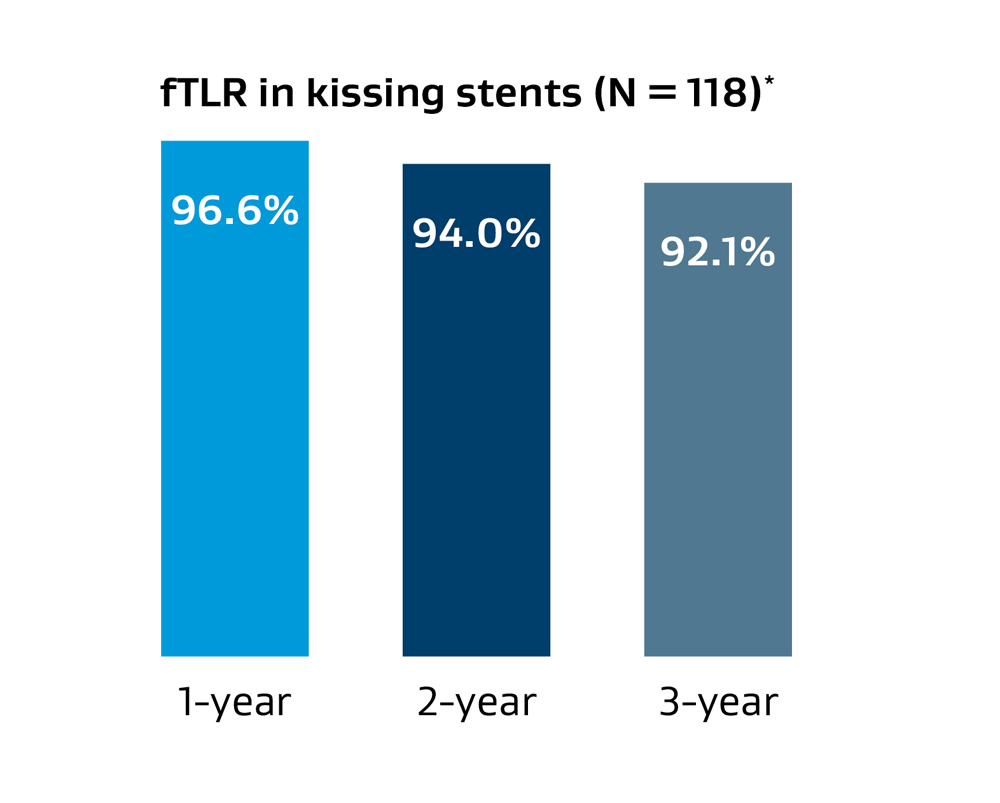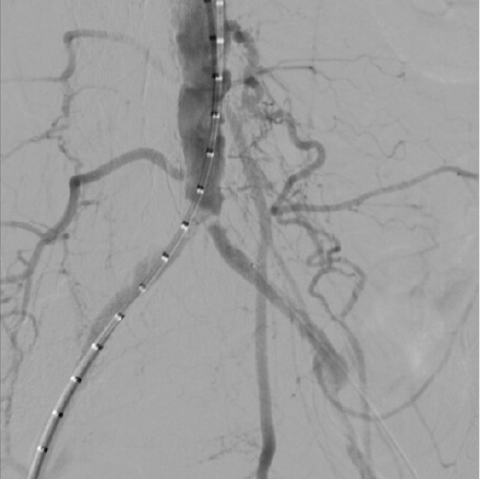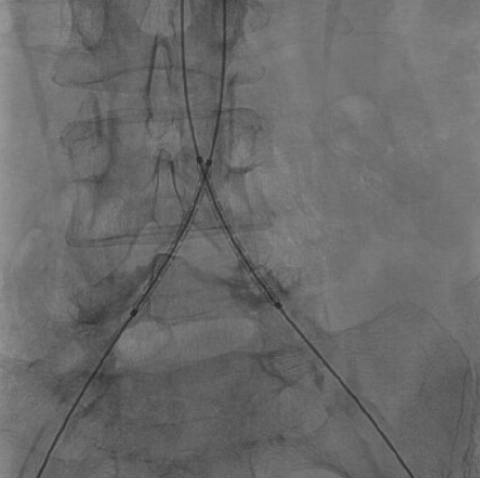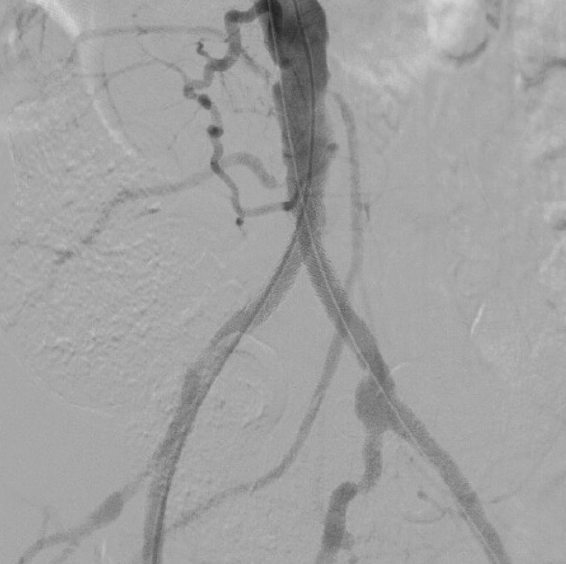GORE® VIABAHN® VBX Balloon Expandable Endoprosthesis Case Studies: Treating severe aortoiliac occlusive disease (AIOD) at the aortic bifurcation
Case submitted by Jean Panneton, M.D.
Norfolk, Virginia
Challenge
- 73-year-old female presented with bilateral buttock, thigh, calf and foot claudication.
- Femoral pulses not palpable bilaterally.
- Relevant patient history:
- Breast cancer, hypertension, hyperlipidemia
- Former heavy smoker
- Baseline ankle-brachial index (ABI) = 0.49 bilaterally.
Procedure
- Angiography revealed severe calcification of the bilateral common iliac arteries with anterior tibial and posterior tibial run-off to the right foot and posterior tibial run-off to the left foot (TASC II D lesion).
- Deployed two 6 x 39 mm GORE® VIABAHN® VBX Balloon Expandable Endoprostheses (VBX Stent Graft) simultaneously in a kissing stent technique (Figure 2).
- Follow-up angiogram showed successful deployment and brisk distal run-off (Figure 3).
Figure 2. Positioning of kissing bilateral VBX Stent Graft.
Images courtesy of Jean Panneton, M.D. Used with permission.
Result
- Post-procedure follow-up revealed resolution of claudication symptoms. Right ABI = 1.01, Left ABI = 0.98.
- At 6-year follow-up, patient remained asymptomatic with normal ABI bilaterally (Figure 4).

Figure 4. 6-year follow-up ABI. Left = 1.05, Right = 1.14.
Case Takeaways
Complex AIOD can be managed via endovascular means with sustained long-term clinical durability. COBEST demonstrated the benefits of using covered stents over bare metal stents for TASC II C and D aortoiliac lesions.1 The Gore VBX FLEX Clinical Study evaluated the safety and effectiveness of the VBX Stent Graft for the treatment of AIOD with freedom from target lesion revascularization (fTLR) in kissing stents at 1 and 3 years, 96.6% and 92.1%, respectively.*
This case highlights the use of the VBX Stent Graft for the treatment of advanced calcific aortoiliac lesions as both safe and effective in appropriate patients with excellent long-term durability.

* Data on file 2020; W. L. Gore & Associates, Inc; Flagstaff, AZ.
- Mwipatayi BP, Sharma S, Daneshmand A, et al; COBEST co-investigators. Durability of the balloon-expandable covered versus bare-metal stents in the Covered versus Balloon Expandable Stent Trial (COBEST) for the treatment of aortoiliac occlusive disease. Journal of Vascular Surgery 2016;64(1):83-94.e1.
Procedural outcomes based on usage of legacy GORE® VIABAHN® VBX Balloon Expandable Endoprosthesis. (BXA catalogue numbers).
The outcomes and observations reported are based on individual case experience and the patients treated. The steps described here may not be complete, and are not intended to be a replacement for the Instructions for Use or the education, training and professional judgment of health care providers (HCP). HCPs remain solely responsible for making decisions about patient care and the use of medical technologies.

Refer to Instructions for Use at eifu.goremedical.com for a complete description of all applicable indications, warnings, precautions and contraindications for the markets where this product is available. RXOnly
INDICATIONS FOR USE IN THE U.S.: The GORE® VIABAHN® VBX Balloon Expandable Endoprosthesis is indicated for the treatment of de novo or restenotic lesions found in iliac arteries with reference vessel diameters ranging from 5 mm–13 mm and lesion lengths up to 110 mm, including lesions at the aortic bifurcation. The GORE® VIABAHN® VBX Balloon Expandable Endoprosthesis is also indicated for use with thoracoabdominal and pararenal branched devices indicated with the GORE® VIABAHN® VBX Balloon Expandable Endoprosthesis as a branch component.*
CONTRAINDICATIONS: Do not use the GORE® VIABAHN® VBX Balloon Expandable Endoprosthesis in patients with known hypersensitivity to heparin, including those patients who have had a previous incident of Heparin-Induced Thrombocytopenia (HIT) type II.
* Not applicable to Reduced Profile GORE® VIABAHN® VBX Balloon Expandable Endoprosthesis. (BXB catalogue numbers).
The GORE® VIABAHN® VBX Balloon Expandable Endoprosthesis is not authorized for use with thoracoabdominal and pararenal branched devices indicated with the GORE® VIABAHN® VBX Balloon Expandable Endoprosthesis as a branch component in Canada.


